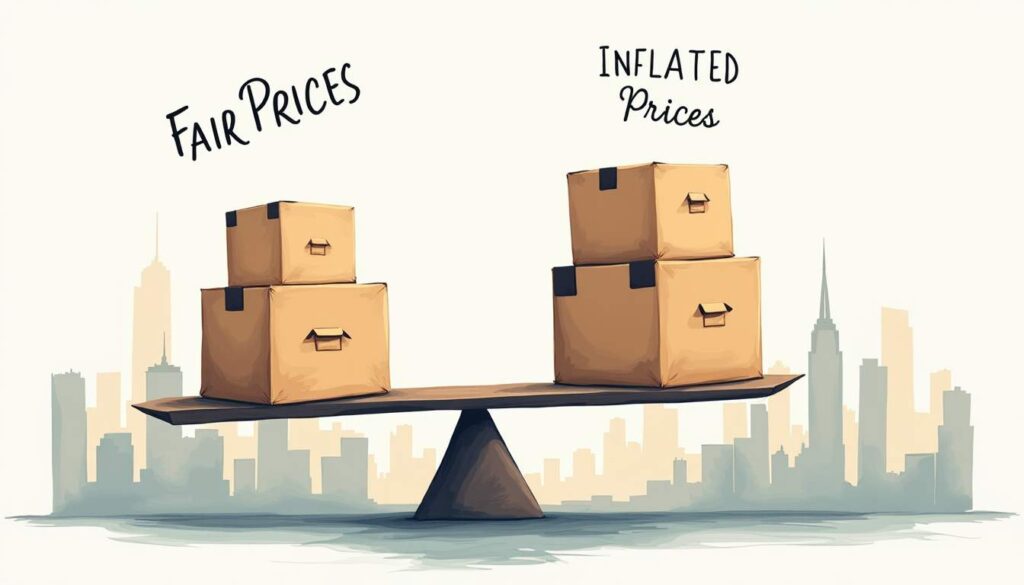Moving can be an exciting new chapter, but it often comes with a hefty price tag that catches many off guard. In fact, studies show that 80% of people underestimate moving costs and find themselves scrambling for extra funds. With the average move costing around $3,020 in 2024, understanding how to differentiate between fair and inflated moving prices is essential for any consumer looking to get the best value for their money.
This guide will walk you through the key factors influencing moving costs, common red flags of price inflation, and practical tips to ensure you’re paying a fair rate without compromising on quality.
Understanding the Components of Moving Costs
Before you can spot inflated moving prices, it’s important to understand what goes into the cost of a move. Moving expenses typically include labor, transportation, packing materials, and sometimes storage. Each of these elements can vary widely depending on the distance, size of the move, and market conditions.
For example, the average hourly rate for movers has increased significantly, now ranging between $65 and $75 per hour, which is nearly 30% higher than it was a few years ago. This increase reflects rising labor costs and the growing demand for professional moving services (My Good Movers).
Fuel prices also play a major role. Diesel costs have surged to an average of $4.60 per gallon in 2024, marking a 17% increase from 2023. This directly impacts the operational costs of moving companies, especially for long-distance relocations (BSETSEARCHSERVICES).
Local vs. Long-Distance Moves
Local moves tend to be less expensive, averaging around $1,489, while long-distance moves average about $3,124. Cross-country moves can vary even more dramatically, typically ranging from $2,400 to $15,000, with most falling near $4,600 (Forbes Home).
Knowing these averages helps set realistic expectations and provides a benchmark to compare quotes from different moving companies. Additionally, it’s essential to consider that local moves are often charged by the hour, which means that the total cost can be influenced by how efficiently the movers work. Factors such as the layout of your home, the distance between your home and the moving truck, and the volume of items being moved can all affect the time it takes to complete the move.
On the other hand, long-distance moves usually involve a flat rate based on the weight of your belongings and the distance traveled. This means that if you have large, heavy items, such as pianos or bulky furniture, you may see a significant increase in your moving costs. Moreover, additional services like packing and unpacking, assembly and disassembly of furniture, and specialized handling of delicate items can also add to the overall expense, making it crucial to get a detailed estimate that outlines all potential costs involved in your move.
Common Signs of Inflated Moving Prices
Spotting when a moving quote is inflated can save you hundreds or even thousands of dollars. Here are some common warning signs to watch out for:
1. Quotes That Are Too Low or Too High
While it might be tempting to go with the cheapest quote, extremely low estimates can be a red flag for hidden fees or subpar service. Conversely, quotes that are significantly higher than the national averages—such as those well above $4,600 for a typical cross-country move—may indicate price gouging.
Remember, in 2024 the average cost of a move is about $3,020, so anything far outside this range warrants closer scrutiny (This Old House). It’s also wise to compare multiple quotes from different companies to get a better sense of what constitutes a fair price. This can help you identify outliers and make a more informed decision about which mover to choose.
2. Lack of Transparency
A reputable moving company will provide a detailed breakdown of costs, including labor, fuel surcharges, packing materials, and any applicable storage fees. Be wary of companies that provide vague or incomplete estimates or refuse to put their quote in writing.
Additionally, ask about any potential extra charges that may arise during the moving process. For example, if you live in a high-rise building, there may be additional fees for elevator use or long carry distances. A transparent company will be upfront about these possibilities, ensuring you have a complete understanding of what to expect.
3. Pressure Tactics and Upfront Payments
Beware of movers who pressure you to sign contracts quickly or demand large upfront deposits. Legitimate movers usually require a reasonable deposit, but excessive upfront payments can be a sign of a scam or inflated pricing.
Furthermore, take note of how the company communicates with you. If they are overly aggressive or dismissive of your questions, it may indicate a lack of professionalism. A trustworthy moving company should be willing to address your concerns and provide you with the information you need to make an informed decision, without resorting to high-pressure sales tactics.
How Rising Industry Costs Affect Your Moving Budget
Several industry-wide factors have contributed to the rising costs of moving services, many of which are beyond the control of consumers or even the moving companies themselves.
Fuel and Labor Costs
As mentioned earlier, fuel prices have surged by 28% since 2023, significantly increasing the cost of transportation for moving companies. This rise is coupled with a near 30% increase in hourly labor rates, reflecting a competitive labor market and higher wage demands (My Good Movers).
These factors combine to create a baseline price floor that all moving companies must meet to remain profitable.
Warehouse and Storage Expenses
For moves requiring storage, warehouse lease costs have increased by 50% since 2020. This surge impacts the fees charged for storage services, which can inflate the overall moving bill if you need to store belongings temporarily (International Association of Movers).
Tips to Ensure You’re Paying Fair Moving Prices
Armed with knowledge about industry trends and typical costs, you can take proactive steps to avoid inflated moving prices and secure a fair deal.

1. Get Multiple Quotes
Request estimates from at least three different moving companies. This not only helps you gauge the market rate but also reveals any outliers that might be suspiciously high or low.
2. Ask for Detailed Estimates
Insist on a written, itemized quote that clearly explains all charges. This transparency makes it easier to compare offers and identify hidden fees.
3. Research Company Reputation
Check online reviews, ratings with the Better Business Bureau, and any complaints filed against the moving company. A trustworthy mover will have a solid track record and clear communication.
4. Understand Your Moving Needs
Knowing whether your move is local or long-distance, and how much stuff you have, will help you better evaluate quotes. For example, the average American moves about 11.7 times in their lifetime, so many people become familiar with typical costs over time (MoveBuddha).
5. Beware of Extra Charges
Ask about potential additional fees such as fuel surcharges, charges for bulky or heavy items, and costs for packing materials. Clarifying these upfront prevents surprises on moving day.
When to Consider Paying a Premium
While it’s important to avoid inflated prices, sometimes paying a bit more is justified for added peace of mind and quality service.
For instance, if a moving company offers comprehensive insurance coverage, professional packing services, or guarantees timely delivery, these benefits can outweigh a slightly higher price. Given that nearly 41 million Americans moved in 2023, the demand for reliable movers is high, and quality service often comes at a premium (MoveBuddha).
Ultimately, the goal is to find a balance between cost and service quality that fits your budget and moving requirements.
Final Thoughts
Moving is inherently complex and can be costly, but understanding the factors behind moving prices empowers you to make informed decisions. By recognizing industry trends such as rising fuel and labor costs, knowing average price benchmarks, and spotting red flags like vague quotes or pressure tactics, you can avoid inflated prices and secure a fair deal.
Remember to leverage multiple quotes, demand transparency, and research movers thoroughly. With these strategies, your next move can be smoother, more affordable, and less stressful.




